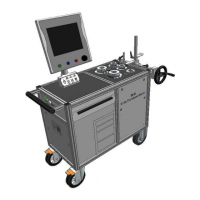Appendix A: Tool Testing Guidelines BLM 3750 User Guide
66 (78) 9836 3078 01 Edition 2.0
11.1 Statistic Control Test
“Statistic control” is a statistical method for preventing errors and for controlling the productive process.
The statistical calculation is based on checking the individual tests on each tool to verify that they are
within the set tolerance limits, and on the sequence of periodic tests to define the tool’s repeatability and
its tendency to go “beyond control”.
The test consists in periodically executing 3, 5 or 7 tests with a tool, to arrive at an average which will be
compared with successive mean values. By analyzing these points in sequence it is possible to determine
the tool tendency to go “beyond control” or to repeat values which could be improved.
In this way, defective tendencies in the process can be avoided.
The JSB software used with Torque Supervisor applies the following rules in order to determine the tool
status (if bench is customized to a specific customer the rules may be changed), and if not ok the
corrective actions to be taken:
In the next figures the following symbols are used:
• At least one value out of tolerance limits:
(or specification limit)
(or specification limit)
Average of a set (typically 3, 5 or 7
tests) of a statistic control test

